Yes, you zadolbali your information society
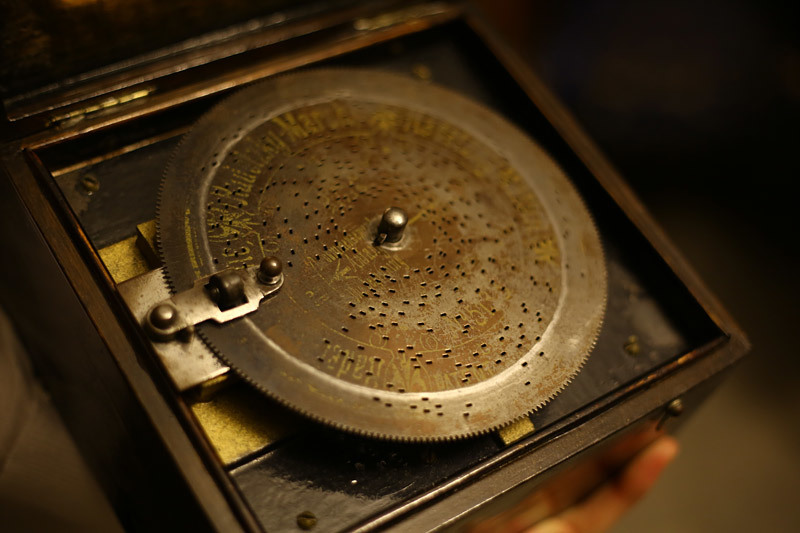
Disc with music. It works almost like an audiocd.
Suppose you want to send an urgent message to your colleague. Today you send mail, a message on the social network or SMS.
Get down below in history. What happened before that? Fax. It was the equivalent of a modern e-mail: the message was transmitted instantly, got out of the device and was ready for reading.
')
We go deeper. There is no fax machine either. You are sending a telegram. Just serious telegraph nodes were pushed out of the backbone phones. The exchanges learned the news by telegram. British journalists from the farthest corners of the world reported the teletype data. You could call any person to the meeting by telegram, which the special kid would carry to your mail switchboard, and then the second kid - from another local switchboard to the addressee. Almost like a cellular network, only ping more.
We continue the journey. Turning off the electricity, the first lags appear, initially imperceptible. Here in Prague there is a full-fledged pneumomail. They wrote a letter with a pen, dried it with sand and blotting paper, put it in a special capsule. Out! The capsule flew to the other end of the city. By the way, if you pick out the optics from the trunk, you can arrange pneumatic mail in the protective tube, so that partially backward compatibility is preserved.
Informational messages
Further lags become more serious, and the risk of damage to the packages - higher. We are switching to primitive biotech. Ready bioplatforms successfully compete with mechanisms. Postal pigeons provide quite tolerable speed. True, they are relatively stable only within the limits of one day of flight, and only being launched from a hill (to speed up primary orientation). Otherwise the pigeon is difficult. Navigation without elevation is loaded for a very long time, up to a couple of hours. By night, the pigeon includes a food search and shelter routine. Pigeons can attack predators. In general, a good fit subdued pigeon moves quite normally along explored routes like Paris-Brussels, at a distance of about 1000 kilometers. Lag for about a day.
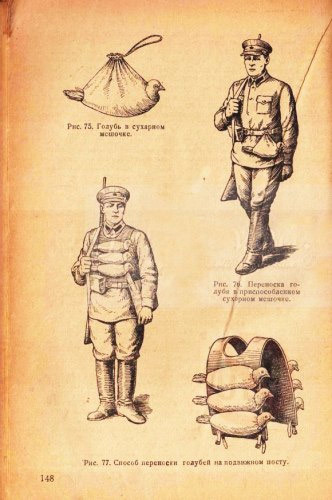
The pigeon has one fatal flaw: it is not produced here. Simply put, half-duplex pigeons: they can send a summary from an unfamiliar area, but sending a pigeon to where he did not live is impossible. But the dove is not bearing (as opposed to a radio station), which was a gift for the French troops in 1914. At that time, about 200 thousand pigeons were put into service, and they were later released even from the sides of reconnaissance aircraft.
But back to an era without electricity. The speed of messages "from the center" is limited by the maximum speed of transport. In the final case - the ship and the horse. For messengers on land, special relay services (CDN) are equipped - places with fresh horses. This allows you to reduce the delivery time of the package about one and a half times.
Plunge deeper. Information density is getting lower, lag is higher, MTU is less. Around the kings (kings, khans, and so on) the "fog of war" thickly condenses. What is happening in the province at a distance of 500 kilometers from the rate is not clear. Optimally send messengers. Considering the risks of intercepting letters, their loss, misunderstanding, and so on, it becomes much more profitable to use special people as carriers who can not only transfer orders, but also answer questions and then check. And the performance report without distortion. And so that such a person can be trusted.
Please note the information was "smarter." Today we send just a small minimally necessary piece of data like: “We will meet at 18:00 on Tverskaya” with an understanding of complete control and the ability to communicate. Previously, it would have been a call in advance or a letter discussing all the details and plans of B: what to do at 18:30, where exactly the meeting, how to know each other, and so on. And at the deepest level of history, we send “smart self-organizing information” in the head of a vassal with an understanding of the goals of the ruler and the authority to create everything to achieve them.
It’s just that the letter couldn’t be limited because of overwhelming paranoia - every local node cannot be bypassed, so the situation is quite normal when the governor of the region does not see the king for ten years. With the next status update, it may turn out that there are already two cities there, and the local “prince” has an army ready to capture your capital. The same Mongolian empire suffered most of all - according to some information, the order could go one way over a couple of years (taking into account the suddenly attacked messengers and the speed of delivering information about it to the point of departure).
Multimedia
What a modern photo, video and sound looks like, you know. Usually, by the way, in the application aspect - as a phone shovel. CDs, tapes, discs and wax cylinders for sound recording are also not needed, I guess.
The photo used to be more interesting. First of all, the wet collodion process, which is almost popular as a modern digital photo, allowed normal exposures, but it required very quickly (until the sheet dried) to show frames. If you were shooting a city from a balloon, you had to have a laboratory in the basket. Plus, no copies, as with the film - how many shot, so much you and frames (but the frame can be reshoot at home again).
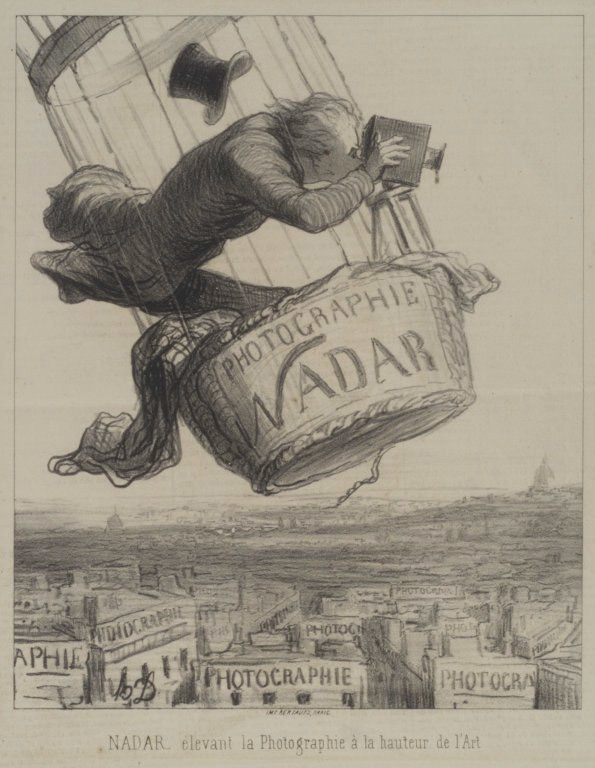
This caricature is similar to our “photographers burning plant" broke - pay attention to the city signs
Prior to that, there was a slow and kayfaya photograph on silver sheets - until the heap the shutter speed was in about 40 minutes, which gave rise to a whole industry of forks under the head, so that the one being portrayed would not move it much.
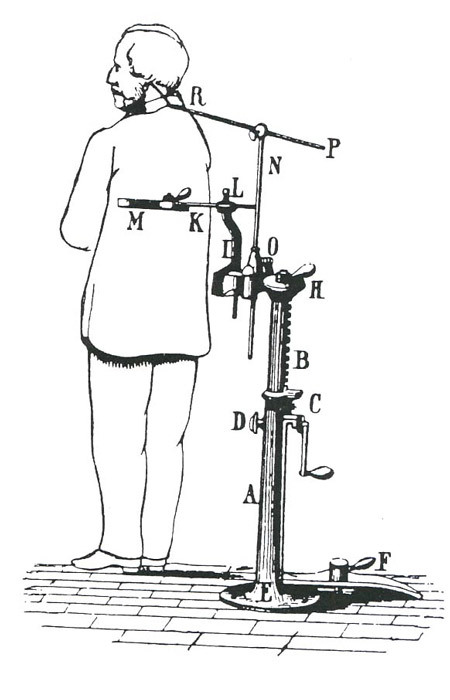
Well, it is also worth mentioning such a wonderful genre, as a posthumous photograph. It was more popular wedding, by the way.
Disclosure of personal data? You are welcome. Here the criminal resists, does not want to be photographed. Because if you succeed in a portrait, it will be recognized in the future as a nefig to do:
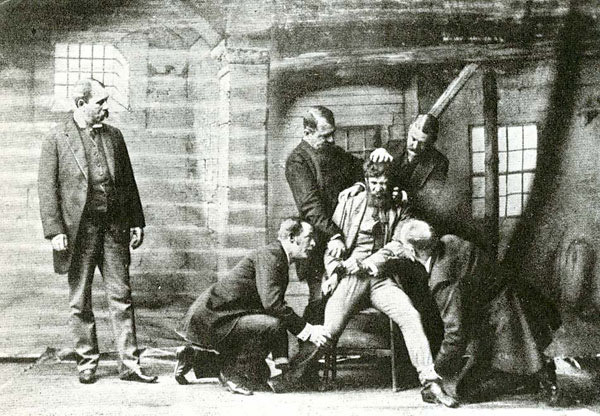
Big brother eyeing him. There were real protests in society against such interference with privacy and for the preservation of PD.

It turned out that such a stand was “wanted by the police”
Mailings (even postal) yet. Broadcast is done by a newspaper, a tabloid on the main square or, even earlier, by a herald. Like an echo: come, take an update, go home. Or neighbors told. At the same time, emergency notification systems were utilitarianly located on churches and similar objects. The bell will not miss.
The video was born painfully long and, largely due to the long wager of two respectable gentlemen who decided to check whether the horse has a soaring canter when all the front legs are in front, and all the rear legs are in the back. As a result, we had to make the first trigger cables for three dozen cameras, synchronize the shutters with electricity, and then think about how to quickly show the photos.
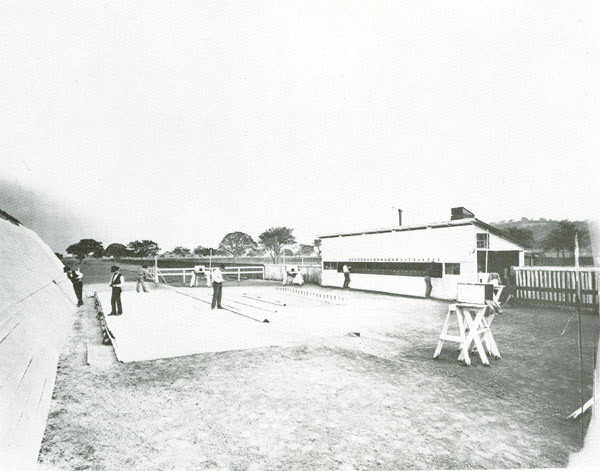
The same farm
At first there were slot drums, then such an analogue of an animated GIF-image appeared on a hand-crafted one:

850 cards in this particular device last for about a minute watching tango. Twist it with your hands, so you can arrange and slow motion. The device is called a "Mutoscope." If you put it in a box with a coin acceptor, then there will be a training film, as in Biosok automats.
Regular letters could contain attachments. Popular means to convey information - perfume on the letter, a strand of hair, photos and drawings. Souvenir and emotion. By the way, do not think that mail has restricted traffic. Darwin sent 7591 letters in his life — large such papers with 2-3 kilobytes of text and, sometimes, drawings. By the way, you did not have the sent letter (there are no typing machines or at least a copy).
What was then with the players? Here is an example. By the way, adjust the volume of the music can and should door:

And deeper than him - not even a record, but 4-bit music on an iron disk with holes.
We degrade further. Reading remains only out loud, the skill to read "about myself" leaves. Now we read like a virtual machine in the head, but then it was your speech. She believed much stronger.
By the way, to the heap - the gaps between words - this is very, very, very progressive. Previously, they were completely unnecessary.
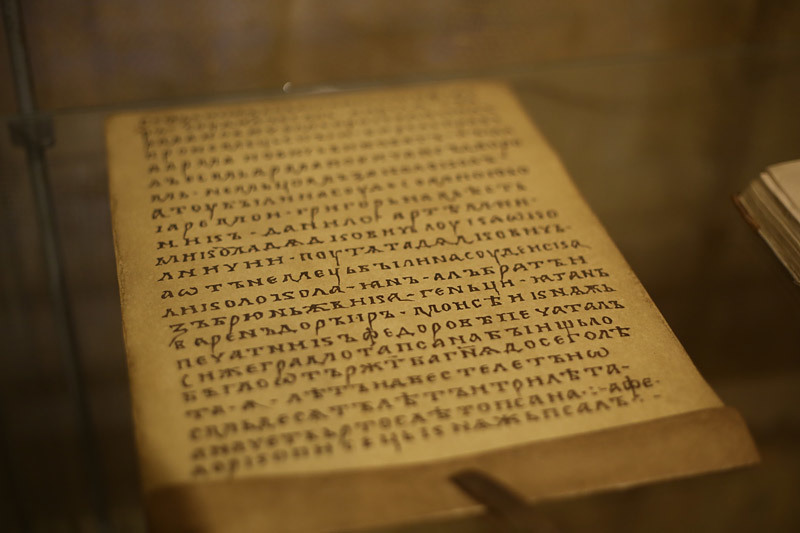
Reconstruction of the text of the time of ancient Russia. Here at least there are punctuation marks: even earlier, colored letters were used instead.
Deeper into the story - and the photo disappears. Only the drawings remain, not always accurate - but at least they allow us to remember and show what cannot be expressed in words. Further, instead of animation, sets of figures are used, for example, from clay: from them it is possible to show even the whole great battle of two warriors in the “storyboard”. You can buy yourself a freeze-frame for your home, or you can buy the entire collection so that you can see the movements along the steps. The main thing is not to confuse the order. Well, and more vazopis - almost the full analog of instagram, only on vases.
Further further, the educational and educational information (not urgent) turns into an oral epic. As modern psychologists have found out, the stories about the inhuman memory of the carriers of the epos are not true. To memorize a ballad of half a megabyte of text - the navel will untie. Therefore, as shown by the experiments, the narrators memorized the key points of the plot and the poetic rhythm. The rhythm made it possible not to retreat too far from the plot, because you cannot easily replace the necessary words. True, considering that it almost always was something like a heavy hexameter, which can be driven in kilometers in real time, it took a further investigation. And, oppa, a surprise from cognitive psychologists. It turns out that "the same ballad" could differ in length by three times in different versions. But if the key points of the plot are preserved, then all versions are perceived identically. Just insane how magical the cmp instruction was then.
Data centers
Given the speed of information dissemination, two natural factors were formed:
- It was easy to keep secret information that requires serious research. It was possible to store technology for centuries without fear of copying.
- The speed of updating information and other aspects required the appearance of information centers where it was possible to obtain the necessary data.
An example of the first case is the samurai training technology. Just imagine that you have the technology of 12-year workouts in the clan, which is guaranteed to make the warrior almost invincible by most opponents. 3-4 such warriors in a clan are like an antique nuclear bomb. These technologies are very strictly protected, so that the neighbors do not know.
I remind you that the transfer of professions was also shop or dynastic then - it was very difficult to just pick up and learn something without approaching the right people. Yes, there is antiquity, for example 15 years ago it was an incredible happiness for me to find information on the desired topic, at least in a book. At least in the regional library. And now we can reach out to any person on the planet and ask him directly, or find the finished material. The difficulty is to perceive information, not to receive it. Previously, it was getting the main quest.
Here, look, the public data center of antiquity. More precisely, what was left of him:
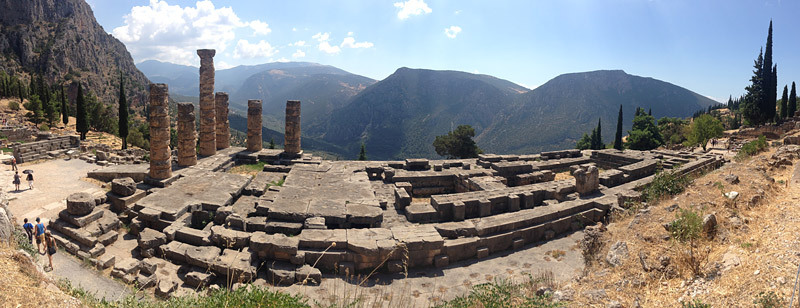
This is the temple of Apollo at Delphi. Here the knowledge base of Ancient Greece was concentrated, and here was the center for settling conflicts. There were several basic services. First, there lived predictors who could ask a question like Google. The answer was usually recursive, but that didn't stop anyone. Secondly, the issues of registration of social information were solved here - marriages were formalized, for example. The builders of this particular data center, in exchange for a bunch of rare marble, bargained for their priority traffic at weddings. Well done, the rest were in a long line. Further, there were concentrated a lot of different people waiting for trials, answers to questions, religious rites. At such an object, it was possible to quickly acquire knowledge from 6-7 neighboring countries. Since the main carrier of information was oral tradition, libraries did not play a decisive role in domestic and administrative traffic. And, again, the emperor to drive to the data center for the counting of the country's readiness for war (a month there, a month back, a month there) is quite a normal practice.
In general, the state of “king offline” was quite frequent, so that cross-cybernetic control systems were formed, tied to the rights of certain people. Informational links between the traveling leader and his stake needed to be encrypted and hidden - hence the high progress in cryptography and steganography in antiquity. Well, in paranoia. Decision-making systems are also up to the mark - various weighted assessment institutes operated from Veliky Novgorod to Rome, resembling dialogues of modules of expert systems. You will be in Novgorod - look at the local Kremlin museum and try to understand the training and management system; You will find a couple of surprises.
Books
In general, the post began with this. Since I published my book (here is a post about the process on Habré), I also wanted to dig a little deeper into the market and see models for the dissemination of information in past centuries.
So here. Modern code (book with pages) - it did not appear immediately. Passing clay tablets and well known to many Kameniuks with cuneiform, I really want to draw your attention to papyrus. This initially white-green thing over the millennia became yellowish, but still continued to bend. And the text was read without distortion. Weak to do so with modern paper?
The first books were either ritual (religious) or contained useful life hacks. For example, instructions on how to purify water, various medical knowledge, and so on. Interface - scrolls, similar in structure to modern one-page sites. Please note that the code (page) can be turned right to the middle, but the scroll can only be read from beginning to end. And another scroll is unbreakable - there were even horizontal scroll books, where galley letters with a text about a journey were on top, and a comic with a journey was at the bottom, such a long continuous picture. Very informative.
At the end of the piece at the end of the artwork, things that we would call social widgets today could easily have come together. “Let everyone who reads and doubly rewrites accompanies happiness” - this is the most modest thing there could be. Metadata was placed on the protocol outside the list; in Chinese libraries, for example, the scrolls lay butt-in to the hall, and this very protocol hung from the butt. There could be complaints about the salary of a scribe, counting cows in debt to Efim, and so on.
Scrolls could not be very long, and could not be read in chunks (which was often necessary in the same sermons or in reading reference books) - so grew the need for Codex interfaces. The technology of the pages has been debugged for centuries: for example, in early releases there were special straps that would not allow the book to be opened too broadly so as not to damage the binding. Read at an angle of 90 degrees, take care of the culture.
Time
The time of the medieval man was determined far from the clock, and the sun. Or bells to prayer. Minutes, hours, exact time - all this came later and introduced a completely new framework in the perception of time. Remember the famous watches on the chain, so popular in England? They were like a cell phone now - with their help, it was possible to navigate in what is happening.
A couple lifehacks were used. The first is litany as a means of measuring time. 15 times prayer is like a playlist for a modern person. The number of prayers pronounced was conveniently recorded on the rosary, by the way.
The second life hack is synchro. For precise coordination of the work of the team, rhythms with a single expiration point were used. “Eh, dubinushka, uuuhny!” - this is a utilitarian thing that allows you to synchronize efforts up to 30-50 people. Again, a special person with a drum or screaming at the desired rhythm was used for rowing. Musicians appreciated the ability to amuse at feasts, but also for practical utility in tedious hard work. Now the same role is played by white headphones sticking out of the head of a person running around in the mornings.
Social networks
For obvious reasons, dating sites and “dossier” files for people have never been special before. In Victorian England, Who is Who directories were issued listing all the aristocracy with the performance characteristics, but this was not enough. The fact that social networks are now solving was solved by several institutions at once:
- Instead of updating Twitter, one could go to confession (which is typical, the same feelings and the same lack of privacy as when posting photos from yesterday's party).
- Instead of dating sites and social networks were balls as tools of cross-pollination. There is a whole set of rules - who can communicate with whom, who approaches whom and so on. In the degenerate case, a cadet could learn to dance for three to five years in order to touch a living woman from the upper class.
- The role of entertainment was played by various games on social events. For example, almost complete reconstruction of one of them . 3D-photos were very popular (stereopairs, watching a dozen or so replaced movies), played forfeits, various card games with stakes, games for the ability to control emotions and dexterity. Depending on the historical period and the region, the coolest game could be either simple poker, or complex preference, or, in general, as happened in France, petanque on the street. Again, golf in England. Of course, there was always a hunt (it's like going to the country for the weekend). By the way, note that hunting and playing in classic English are called in one word - game.
- Until recently, authentication was performed using a special submission procedure. Even earlier, especially in the East, the entire file was “stitched” in the name - for example, there could well be a login, registration city, postfix marital status, father's name, profession, and so on. Something similar was in European aristocrats: long names with titles, possessions and brief information on the genus. The ancient Slavs and neighboring nations did not have such colorful names, but they used codes on clothes, weapons, vehicles (for example, chariot), and various household items. The most well-known type of authentication is the color and pattern of the sail in the sea, or the color and pattern of the upper shirt on the ground. In wartime - avatar-coat of arms on the shield.
Therefore, the next time when you decide that different difficulties are connected with the fact that we have an information society in the yard and information overload, remember that our ancestors had the same age and two, five, and ten ago tools and problems. And even wireless irons.
Source: https://habr.com/ru/post/274373/
All Articles